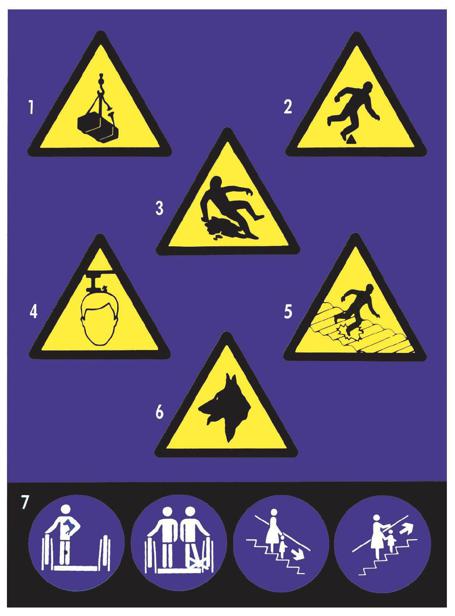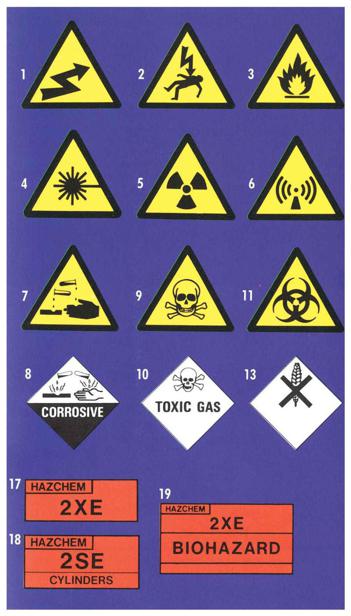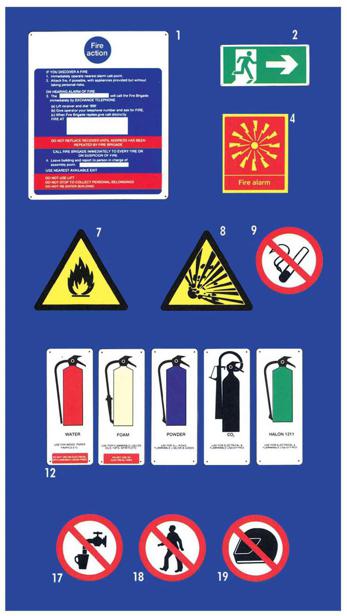SAS Urban Survival Handbook (106 page)
Read SAS Urban Survival Handbook Online
Authors: John Wiseman
Tags: #Health & Fitness, #Reference, #Survival, #Fiction, #Safety, #Self-Help, #Personal & Practical Guides, #General, #Survival Skills

All green symbols offer information and/or guidance and are there for your safety. They are often combined with directional arrows, telling you how to reach a first-aid station or emergency showers for example. Fire exits and fire escape routes are usually shown in green.

PHYSICAL RISKS
These symbols are aimed primarily at the workforce, but visitors and members of the public are also required to take note.
1▶
Beware! Objects or heavy loads may come crashing down on you.
2▶
Trip hazard. This indicates that there is a change in ground level, an uneven surface or there is debris lying about.
3 ▶
Slip hazard. Ground or flooring may be greasy or wet. All people are at risk unless wearing non-slip footwear.
4▶
Overhead danger. There are sharp projections or obstacles which may cause severe injury.
5▶
Roof covering is unsafe—do NOT attempt to walk on it without crawlboards. Risks may be very severe.
6▶
Guard dogs on patrol. They don’t ask questions!
7▶
Escalator signs to remind you to carry dogs (and small children!), not to stand with your foot near the edge of the step and to face the direction of travel. Even if YOU feel safe on escalators, there is always the danger that someone behind or in front of you may fall and take you with them.


SUBSTANCE HAZARDS
Risks may be very serious indeed. Usually, accompanying warnings spell out the dangers and the emergency action required. These signs may indicate that you should not even be in the vicinity of the substance, or may instruct you to wear proper protective gear.
1▶
There is a risk of electrocution—possibly involving very high voltages above normal domestic or three-phase power.
2▶
Voltages may be high enough to arc across a gap—even getting close could mean risking death.
3▶
There is a severe risk of fire—perhaps from a flammable substance or a heat-producing process.
4▶
Lasers in use. Degrees of danger usually indicated, from class 1 (low) to class 4 (high). The higher the class, the greater the risk to eyes, skin and tissues.
5▶
Radioactive hazard. Risks may be slight (class 1) or severe (class 3). Read the warning which will indicate the type of radiation—gamma rays or x-rays, perhaps, which are ionizing radiation.
6▶
Non-ionizing radiation. Risks are low but exposure should be minimized.
7 & 8▶
Corrosive substance likely to burn skin and tissues. There may be other qualifying notices.
9▶
A skull and crossbones is another multipurpose sign, often indicating toxic dangers, as in
10. 11▶
One of the more recent signs—biohazard. These may be viral, fungal, bacteriological, disease or genetic hazards.
12▶
Biohazards are usually explained more fully.
13▶
Harmful substance. Keep away from foodstuffs.
14▶
Usually accompanied by the words harmful or irritant. Common on domestic products.
15 & 16▶
Intended for the workplace, but serve as a reminder to all that when CO
2
or halon fire extinguishers have been discharged, the area MUST be evacuated and ventilated.
17-20▶
These are the most common variations of hazchem (hazardous chemical) warning signs. The codes indicate the measures the fire brigade must take to deal with a fire involving potentially dangerous substances (see WORK & PLAY). These symbols are commonly seen on haulage vehicles.


FIRE
1▶
A typical example of a fire drill notice—intended for the workplace, but could be adapted for the home.
2▶
Escape door or emergency exit this way. There may be colour-coded arrows to follow if the route is complicated.
3▶
The tick indicates an assembly or muster point, where a personnel check can be made to ensure that a building has been fully evacuated.
4,5 & 6▶
Self-explanatory because of the added wording. Now you know where the extinguisher and hose are, do you know how to use them?
7▶
Fire hazard.
8▶
Risk of explosion.
9 & 10▶
Obvious! No smoking. No naked flames. If you see these, DON’T ignore them.
11▶
If a fire breaks out here, DON’T use water or a water extinguisher.
12▶
Extinguishers are colour-coded—use the right type for each fire (see
FIRE!).
GENERAL WARNING
13▶
Any message preceded by an exclamation mark means: Read this ... you are at risk.
14▶
Standard symbols to indicate: Keep dry. Fragile (treat as glass). This way up. There are hundreds of variations on these worldwide.
15▶
Litter may be a nuisance, but it may also be a severe hazard or a fire risk.
16▶
Smile! You’re on closed-circuit television (CCTV)!
17▶
NOT drinking water.
18▶
No pedestrians. Can also mean ‘keep out’, which might be for your safety.
19▶
No crash helmets! Take it off before entering a building/area, especially where money is handled—or you could be mistaken for an armed robber.
20▶
No dogs.
21▶
No comment!
10
Terrorism
Who knows where terrorists may strike next? Everyone is a potential target, now that innocent ‘bystanders’ are used as pawns in attempts to apply political pressure. High-risk targets must toughen up their security.
TERRORIST THREAT
Are you at risk? • Prime targets
BOMBS
Detection • Save lives • If you receive a bomb threat • Hoax or real? • Letter bombs • Vehicle bombs • Expert searches
HIJACK/KIDNAP
Hostage! • Rescue • Kidnap! • Escape • Ransom • Tied up/gagged
UNDER FIRE
Hold-ups and robberies • Holding an attacker • Post-event stress • Body search
RISK LIMITATION
Preventing intrusion • Staff training • Alarms • Evacuation • Bomb search • High-security lifestyle
BULLET/BLASTPROOFING
Glass • Clothing
TERRORIST THREAT
 Terrorism is not new. The destruction of property, murder, assassination, kidnap and hostage-taking have long been the tools of those who believe that violence is a means of achieving political and criminal goals. What makes modern terrorists distinct from their historical predecessors is the technology at their disposal and the greater range of opportunities for terrorism which modern life provides – aeroplane hijacking being just one example. More value is now placed on the lives of ordinary people and it is they – not just the rich and powerful – who have become targets.
Terrorism is not new. The destruction of property, murder, assassination, kidnap and hostage-taking have long been the tools of those who believe that violence is a means of achieving political and criminal goals. What makes modern terrorists distinct from their historical predecessors is the technology at their disposal and the greater range of opportunities for terrorism which modern life provides – aeroplane hijacking being just one example. More value is now placed on the lives of ordinary people and it is they – not just the rich and powerful – who have become targets.
The global nature of media coverage and the publicity it can give has also fuelled the use of terrorism. There is no doubt also that some nations finance and support the activities of terrorists in other countries with which they have political differences.
The more innocent the victim, the better for terrorism. The reality is that we are ALL potential targets and that we are ALL vulnerable.
How terrorists work
Injury, torture and murder have been tools of terrorists both to destabilize a community through fear and to deter opposition—whether the perpetrators are acting against an established government or in the name of a political cause. Bomb attacks and assassination, however, tend to bring the greatest publicity. They draw attention to a cause and seek to weaken authority. By taking hostages, terrorists may bargain for political concessions or the release from prison of fellow terrorists and sympathizers. Bank raids, kidnap and blackmail may be employed to raise funds to finance their activities.
Not all terrorists are motivated by political aims, the same tactics may be used for direct financial gain or personal revenge. Terrorism has also been adopted by certain ‘extremist’ groups, who feel a need to use violence (as opposed to peaceful demonstration and political pressure) to further their cause. But high on the list of motivation remains racial or religious hatred and intolerance.
